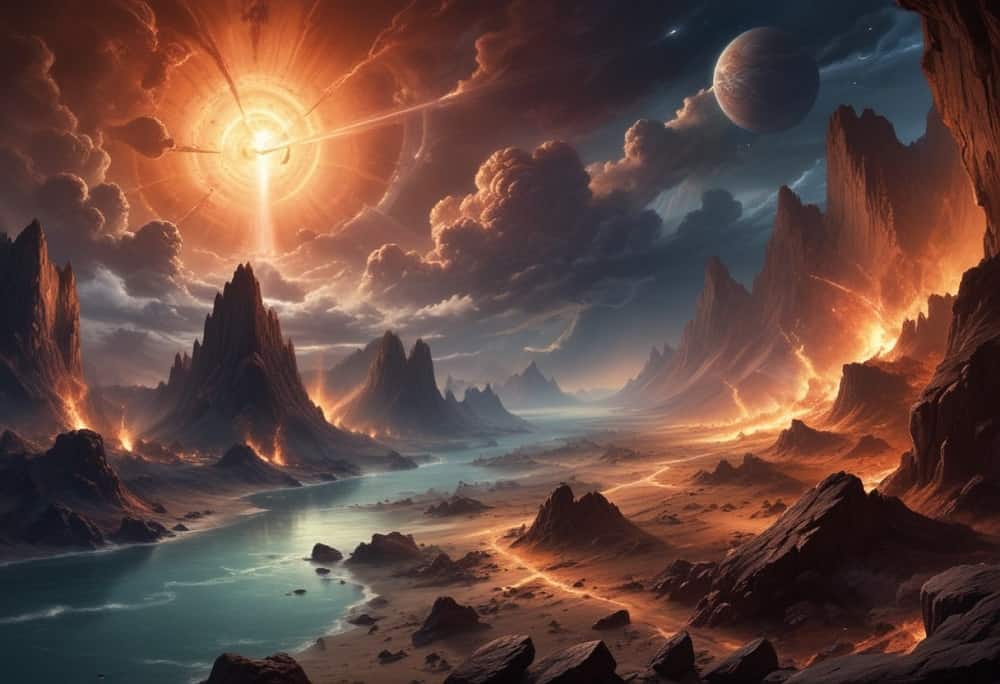Did you know that numerous elements played pivotal roles in the genesis of life on Earth, and among them, the Earth's atmosphere takes center stage? When our young planet coalesced eons ago, it lacked the protective veil of an atmosphere. However, as it gradually cooled, a chorus of volcanoes erupted, unleashing a torrent of gases—water vapor, carbon dioxide, nitrogen—into the void. These gases coalesced, birthing the nascent atmosphere that enveloped our world. Over epochs, life emerged from the primordial soup. Early pioneers, humble bacteria and algae, mastered the art of photosynthesis, exhaling oxygen into the newborn skies. Thus began the gradual accumulation of oxygen, enrobing the Earth in its life-sustaining embrace. Like a snug cloak, the atmosphere enveloped our planet, ensnaring the Sun's warmth and nurturing the cradle of life. It is this ethereal embrace that regulates temperatures across the globe, orchestrating the dance of seasons that defines our world.
Certainly! The history of Earth's atmosphere is a fascinating tale that spans billions of years. Let's take a journey through time:
Formation
The Earth formed about 4.5 billion years ago, and its early atmosphere was likely composed of gases emitted from volcanic eruptions, such as water vapor, carbon dioxide, nitrogen, and methane. Over time, as the planet cooled, water vapor condensed, forming the oceans.
The Great Oxygenation Event (2.4 to 2.3 billion years ago)
Cyanobacteria, among the earliest forms of life, evolved the ability to photosynthesize, producing oxygen as a byproduct. This led to the "Great Oxygenation Event," dramatically increasing atmospheric oxygen levels and paving the way for the evolution of oxygen-dependent life forms.
Evolution of Complex Life (about 600 million years ago)
The increase in oxygen levels allowed for the evolution of more complex organisms, leading to the Cambrian explosion, a period of rapid diversification of multicellular life forms.
Variations in Atmospheric Composition
Throughout Earth's history, the composition of the atmosphere has varied due to geological processes, changes in biological activity, and even extraterrestrial influences such as asteroid impacts.
Ice Ages and Greenhouse Periods
Earth has experienced cycles of glaciation and warmer periods due to variations in its orbit and axial tilt. These changes have influenced atmospheric composition and circulation patterns.
Human Impact
In recent history, human activities have significantly altered the composition of Earth's atmosphere. Industrialization has led to increased concentrations of greenhouse gases such as carbon dioxide and methane, resulting in global warming and climate change.
Environmental Awareness and Regulation
In response to the environmental challenges posed by human activities, efforts have been made to reduce emissions and mitigate climate change through international agreements and regulations aimed at curbing greenhouse gas emissions and protecting the ozone layer.
Future Challenges and Opportunities
Looking ahead, understanding Earth's atmosphere and its interactions with other Earth systems will be crucial for addressing environmental issues and ensuring the long-term sustainability of our planet.
Throughout Earth's history, the atmosphere has played a vital role in shaping the planet's climate, sustaining life, and influencing geological processes. Studying its evolution provides valuable insights into the interconnectedness of Earth's systems and the impacts of human activities on the environment.














0 comments:
Post a Comment